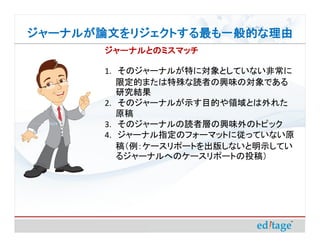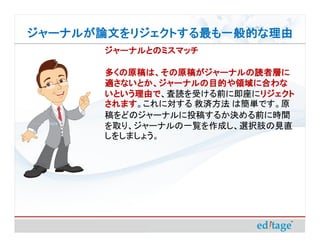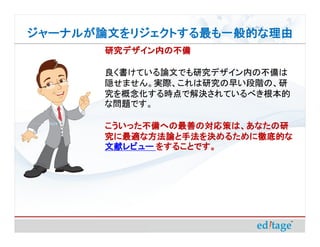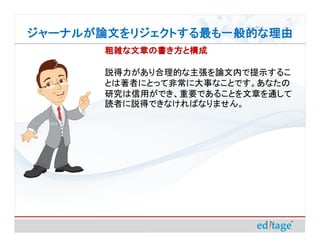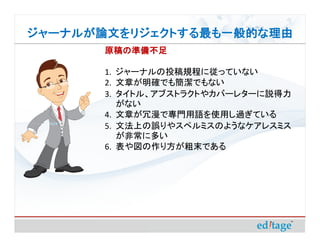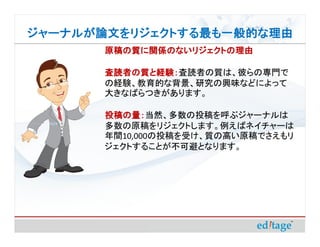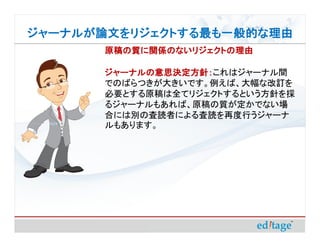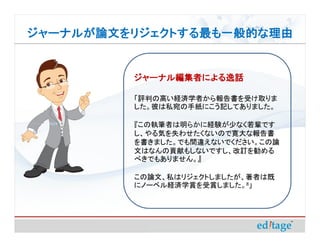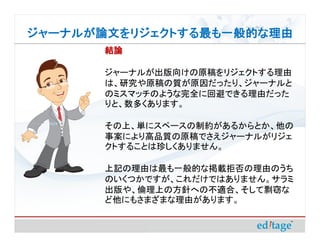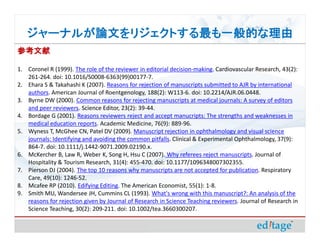ジャーナルが论文をリジェクトする最も一般的な理由
- 1. ジャーナルが论文をリジェクトする最も一般的な理由 Helping you get published
- 2. ジャーナルが论文をリジェクトする最も一般的な理由 学術出版では、論文のリジェクトはよくあることです。 ある研究分野でトップレベルの研究者でさえリジェクト を経験したことがあります。 ジャーナルが論文をリジェクトする理由について、いく つかの査読付き研究論文について調査報告されてい ます。以下に、これらの研究に引用された最も一般 以下に、これらの研究に引用された最も一般 的な理由を挙げました1-13。
- 3. ジャーナルが论文をリジェクトする最も一般的な理由 独創性、斬新性、意義の欠落 1. 一般化できない結論 2. 新しい技術、技法により時代遅れとなった実験 方法の使用 3. 既存知識に何も付加することが無く、出版済み 研究の延長または複製である二次的な分析 4. 既知の知識を新たな地理的、人口的、または文 化的な設定に拡張し、斬新な知識として位置付 けて報告している研究 5. 結果が非独創的、意外性がない、またはさして 重要ではない 6. 結果が臨床的、理論上、または実用的にもなん ら影響がない
- 4. ジャーナルが论文をリジェクトする最も一般的な理由 独創性、斬新性、意義の欠落 アメリカの主要新聞社のひとつであるニューヨークタイム ニューヨークタイム スは「一般にジャーナル編集者は革新的な新研究の出 「一般にジャーナル編集者は革新的な新研究の出 版を好む」という事実を認めました14。学術誌は絶えず刺 版を好む」 激的で新鮮な研究を見つけようと虎視眈々としています。 多くの著者は、なぜ彼らの論文が有意義なのかの説明に 「これはかつて研究されたことがない」という理由を挙げ 「これはかつて研究されたことがない」 る傾向にあります。これでは十分ではありません。研究は もっと大局的に道筋を立てる必要があります。例えばそ の研究はある医療治療の処置に影響があるかもしれな い、または特定の政策協議に関係するおそれがある、も しくは従来の理論や信念を変えるなど、なぜその調査が 重要なのかの具体的な例を挙げるべきです。
- 5. ジャーナルが论文をリジェクトする最も一般的な理由 ジャーナルとのミスマッチ 1. そのジャーナルが特に対象としていない非常に 限定的または特殊な読者の興味の対象である 研究結果 2. そのジャーナルが示す目的や領域とは外れた 原稿 3. そのジャーナルの読者層の興味外のトピック 4. ジャーナル指定のフォーマットに従っていない原 稿(例:ケースリポートを出版しないと明示してい るジャーナルへのケースリポートの投稿)
- 6. ジャーナルが论文をリジェクトする最も一般的な理由 ジャーナルとのミスマッチ 多くの原稿は、その原稿がジャーナルの読者層に 適さないとか、ジャーナルの目的や領域に合わな いという理由で、査読を受ける前に即座にリジェクト いという理由で リジェクト されます。これに対する 救済方法 は簡単です。原 されます 稿をどのジャーナルに投稿するか決める前に時間 を取り、ジャーナルの一覧を作成し、選択肢の見直 しをしましょう。
- 7. ジャーナルが论文をリジェクトする最も一般的な理由 研究デザイン内の不備 1. 研究課題の設定がずさん 2. 研究課題の解決に対するアプローチの概念化 が不十分 3. 説得力に欠ける、または信頼できない実験方法 の選択 4. 不正確な実験方法や研究する課題に不適当な モデルの選択 5. 不適切な統計分析 6. 信頼できない、または不完全なデータ 7. 不適切、または最適ではない器具の使用 8. 選択したサンプルが小さい、または不適切
- 8. ジャーナルが论文をリジェクトする最も一般的な理由 研究デザイン内の不備 良く書けている論文でも研究デザイン内の不備は 隠せません。実際、これは研究の早い段階の、研 究を概念化する時点で解決されているべき根本的 な問題です。 こういった不備への最善の対応策は、あなたの研 究に最適な方法論と手法を決めるために徹底的な 文献レビュー をすることです。
- 9. ジャーナルが论文をリジェクトする最も一般的な理由 粗雑な文章の書き方と構成 1. 実験方法の記述が不十分 2. 考察が解釈ではなく、単に実験結果で述べた事 の繰り返し 3. 研究の理論的根拠の説明不足 4. 文献レビューが不十分 5. 研究データを支持しているように見えない結論 6. 研究に大局的な道筋が立てられていない 7. 研究した課題の背景を立証していない序論
- 10. ジャーナルが论文をリジェクトする最も一般的な理由 粗雑な文章の書き方と構成 説得力があり合理的な主張を論文内で提示するこ とは著者にとって非常に大事なことです。あなたの 研究は信用ができ、重要であることを文章を通して 読者に説得できなければなりません。
- 11. ジャーナルが论文をリジェクトする最も一般的な理由 原稿の準備不足 1. ジャーナルの投稿規程に従っていない 2. 文章が明確でも簡潔でもない 3. タイトル、アブストラクトやカバーレターに説得力 がない 4. 文章が冗漫で専門用語を使用し過ぎている 5. 文法上の誤りやスペルミスのようなケアレスミス が非常に多い 6. 表や図の作り方が粗末である
- 12. ジャーナルが论文をリジェクトする最も一般的な理由 原稿の準備不足 非英語圏の著者は、査読者は常に論文の内容と 文体とを区別しているわけではない、というさらなる 問題にもたびたび遭遇します。そして質の高い研究 問題にもたびたび遭遇します。 であってもネガティブなコメントを受けてしまうことに なりかねません15。 しかしこのカテゴリー内の全ての問題は、英語圏の 友達や同僚に論文を査読してもらったり、プロに論 文を校正、フォーマットしてもらうなどして簡単に解 決できます。
- 13. ジャーナルが论文をリジェクトする最も一般的な理由 原稿の質に関係のないリジェクトの理由 原稿の質の低さがリジェクトの唯一の理由では ありません。ジャーナルの決定に影響を与える 重大な要因がいくつかあります8,11,16,17。 1. スペースの制約 2. 査読者の質と経験 3. 投稿の量 4. ジャーナルの意思決定方針 5. ジャーナル編集者が特定のテーマの論文を 探している場合 6. ジャーナルが同じテーマで1本以上の投稿を 受けた場合
- 14. ジャーナルが论文をリジェクトする最も一般的な理由 原稿の質に関係のないリジェクトの理由 スペースの制約:ジャーナルがスペース不足を主な スペースの制約: 理由として質の高い原稿をリジェクトすることは珍し くありません。ジャーナルは自誌の領域全体に見合 う範囲のトピックについて出版したいのです。印刷 版ジャーナルの編集者は限られた数の記事しか出 版できないため、どの論文を出版するか特によりす ぐらなければなりません。オープンアクセスのジャ ーナルにとってスペースは大きな問題ではないの で、これに関する制約は少ないです。
- 15. ジャーナルが论文をリジェクトする最も一般的な理由 原稿の質に関係のないリジェクトの理由 査読者の質と経験:査読者の質は、彼らの専門で 査読者の質と経験: の経験、教育的な背景、研究の興味などによって 大きなばらつきがあります。 投稿の量:当然、多数の投稿を呼ぶジャーナルは 投稿の量: 多数の原稿をリジェクトします。例えばネイチャーは 年間10,000の投稿を受け、質の高い原稿でさえもリ ジェクトすることが不可避となります。
- 16. ジャーナルが论文をリジェクトする最も一般的な理由 原稿の質に関係のないリジェクトの理由 ジャーナルの意思決定方針:これはジャーナル間 ジャーナルの意思決定方針: でのばらつきが大きいです。例えば、大幅な改訂を 必要とする原稿は全てリジェクトするという方針を採 るジャーナルもあれば、原稿の質が定かでない場 合には別の査読者による査読を再度行うジャーナ ルもあります。
- 17. ジャーナルが论文をリジェクトする最も一般的な理由 原稿の質に関係のないリジェクトの理由 ジャーナル編集者が特定のテーマの論文を探して いる場合:ジャーナル編集者は時折そのジャーナ いる場合: ルがテーマとする事案を出版したがったり、その時 のホットな話題に興味を持ったりすることもあり、こ ういった場合にはその特定のトピックに焦点をあて た記事の方がアクセプトされる傾向にあるかもしれ ません。 ジャーナルが同じテーマで1本以上の投稿を受けた ジャーナルが同じテーマで 本以上の投稿を受けた 場合:このような場合ジャーナルはそれらの原稿の 場合: うち恐らくひとつだけを出版して、その他の原稿は 類似したトピックの論文が既にあるというだけの理 由で全てリジェクトするでしょう。
- 18. ジャーナルが论文をリジェクトする最も一般的な理由 ジャーナル編集者による逸話 「評判の高い経済学者から報告書を受け取りま した。彼は私宛の手紙にこう記してありました。 『この執筆者は明らかに経験が少なく若輩です し、やる気を失わせたくないので寛大な報告書 を書きました。でも間違えないでください。この論 文はなんの貢献もしないですし、改訂を勧める べきでもありません。』 この論文、私はリジェクトしましたが、著者は既 にノーベル経済学賞を受賞しました。8」
- 19. ジャーナルが论文をリジェクトする最も一般的な理由 結論 ジャーナルが出版向けの原稿をリジェクトする理由 は、研究や原稿の質が原因だったり、ジャーナルと のミスマッチのような完全に回避できる理由だった りと、数多くあります。 その上、単にスペースの制約があるからとか、他の 事案により高品質の原稿でさえジャーナルがリジェ クトすることは珍しくありません。 上記の理由は最も一般的な掲載拒否の理由のうち のいくつかですが、これだけではありません。サラミ 出版や、倫理上の方針への不適合、そして剽窃な ど他にもさまざまな理由があります。
- 20. ジャーナルが论文をリジェクトする最も一般的な理由 参考文献 1. Coronel R (1999). The role of the reviewer in editorial decision-making. Cardiovascular Research, 43(2): 261-264. doi: 10.1016/S0008-6363(99)00177-7. 2. Ehara S & Takahashi K (2007). Reasons for rejection of manuscripts submitted to AJR by international authors. American Journal of Roentgenology, 188(2): W113-6. doi: 10.2214/AJR.06.0448. 3. Byrne DW (2000). Common reasons for rejecting manuscripts at medical journals: A survey of editors and peer reviewers. Science Editor, 23(2): 39-44. 4. Bordage G (2001). Reasons reviewers reject and accept manucripts: The strengths and weaknesses in medical education reports. Academic Medicine, 76(9): 889-96. 5. Wyness T, McGhee CN, Patel DV (2009). Manuscript rejection in ophthalmology and visual science journals: Identifying and avoiding the common pitfalls. Clinical & Experimental Ophthalmology, 37(9): 864-7. doi: 10.1111/j.1442-9071.2009.02190.x. 6. McKercher B, Law R, Weber K, Song H, Hsu C (2007). Why referees reject manuscripts. Journal of Hospitality & Tourism Research, 31(4): 455-470. doi: 10.1177/1096348007302355. 7. Pierson DJ (2004). The top 10 reasons why manuscripts are not accepted for publication. Respiratory Care, 49(10): 1246-52. 8. Mcafee RP (2010). Edifying Editing. The American Economist, 55(1): 1-8. 9. Smith MU, Wandersee JH, Cummins CL (1993). What's wrong with this manuscript?: An analysis of the reasons for rejection given by Journal of Research in Science Teaching reviewers. Journal of Research in Science Teaching, 30(2): 209-211. doi: 10.1002/tea.3660300207.
- 21. ジャーナルが论文をリジェクトする最も一般的な理由 参考文献 10. Ajao OG (2005). Some reasons for manuscript rejection by peer-reviewed journals. Annals of Ibadan Postgraduate Medicine, 3(2): 9-12. 11. Ali J (2010). Manuscript rejection: Causes and remedies. Journal of Young Pharmacists, 2(1): 3-6. doi: 10.4103/0975-1483.62205. 12. Turcotte C, Drolet P, Girard M (2004). Study design, originality and overall consistency influence acceptance or rejection of manuscripts submitted to the Journal. Canadian Journal of Anesthesia, 51(6): 549-56. doi: 10.1007/BF03018396. 13. Carpenter WT, Thaker GK, Shepard PD (2010). Manuscript rejection for the Schizophrenia Bulletin: Some reasons. Schizophrenia Bulletin, 36(4): 649-650. doi: 10.1093/schbul/sbq056. 14. Zimmer C. It’s science, but not necessarily right. The New York Times. June 25, 2011. 15. Kumar M (2009). A review of the review process: manuscript peer-review in biomedical research. Biology and Medicine, 1(4): 1-16. 16. Schultz DM (2010). Rejection rates for journals publishing in the atmospheric sciences. Bulletin of the American Meteorological Society, 91(2), 231-243. doi: 10.1175/2009BAMS2908.1. 17. House of Commons Science and Technology Committee (2011). Peer review in scientific publicationsVol 1. House of Commons: London, UK.
- 22. Connect Connect with us on: http://www.facebook.com/EditageJapan https://twitter.com/EditageJapan http://www.linkedin.com/company/cactus-communications





